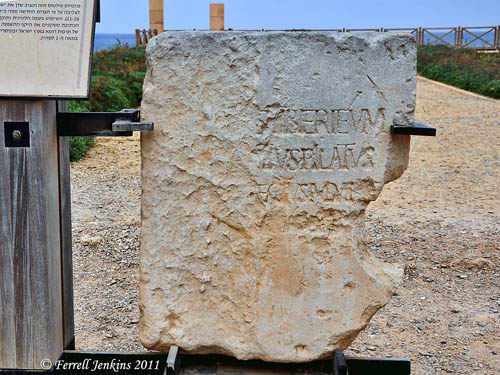About 1968 I was speaking in Lethbridge, Alberta (Canada), on Christian Evidences (or Apologetics). At the close of the lessons one of the attendees said, “I would believe, except for all of the contradictions in the Bible.” Already I had learned that “all of the contradictions” were too big for me to handle at one time. I said, “Name two.” He said, “There is no record of Pontius Pilate outside the New Testament.”
Pilate is mentioned no less than 56 times in the New Testament. Most of the references are in the Gospels (Matthew, Mark, Luke, and John). There are four references in Acts (3:13; 4:27; 13:28), and one in 1 Timothy 6:13.
I charge you in the presence of God, who gives life to all things, and of Christ Jesus, who testified the good confession before Pontius Pilate, (1 Timothy 6:13 NAU)
Except for Luke 3:1 and 13:1, the references in the Gospels are clustered in the final chapters of each book, the section dealing with the crucifixion of Jesus (Matthew 27; Mark 15; Luke 23; John 18-19).
I have no idea why one would think that having no external reference to a person named in the Bible would mean that the Bible was not true.
In fact, there are many literary references to Pilate outside the New Testament. A quick computer check shows at least 21 references to Pilate in Josephus (Antiquites and Jewish Wars).
Note this brief paragraph by Gary R. Habermas from The Historical Jesus: Ancient Evidence for the Life of Christ, page 221.
After suffering persecution (Gospel of Truth) and as a result of his teachings (Lucian), Jesus was put to death (Gospel of Thomas, Treatise on Resurrection). He died at the hands of Roman procurator Pontius Pilate (Tacitus), who crucified him (Josephus, Talmud, Lucian, Gospel of Truth, Acts of Pilate) during the reign of Emperor Tiberius (Tacitus, Phlegon).
And there is much more in Habermas’ book about Pilate, as well as in other secondary sources that point to the primary sources.
Pilate is well attested on Roman coins. Many coins were minted during the reign of Pontius Pilate as Prefect of Judea under the Roman Emperor Tiberius. Check Jean Philippi Fontanille’s Menorah Coin Project here. Scroll down to Pilate, click on one of the coin images and you will be able to spend as much time as you can afford in one day learning about the coins of Pilate. Fontanille is author of The Coins of Pontius Pilate (Marco Polo Monographs series)
I was able to say to the skeptic in Lethbridge that an inscription bearing the name of Pilate had been found at Caesarea Maritima in 1961. The photo below shows a replica of the inscription which was found in the excavation of the Roman theater. The original is in the Israel Museum. A large copy suitable for use in teaching presentations is available by clicking on the image.
In an earlier post I mentioned that this inscription was found June 15, 1961. A reader who is doing research on Pilate asked about the specific date. As I began to look at various books dealing with archaeology, I noted that all I have looked at only mention the year 1961. In 1976 I self-published a book called The Book and the Land (now OP) primarily for use by persons joining my tours to the Bible Lands. Since that time I have thoroughly and continuously updated the material in connection with various tours. In those works, beginning in 1976, I cited The Israel Digest, a publication that I received for several years. I usually clipped the pages I was interested in and filed them. I spent several hours recently going through a multitude of folders without locating that particular page. However, I have had some success.
A snippet view of a volume containing The Israel Digest for 1966 is available at Google Books here. Fortunately it contains a snippet showing the date that the Italian Expedition, headed by Prof. Antonio Frova, discovered the inscription. Click on the 1961 book and then search for Pilate. The digitized original is said to be from Indiana University.
Well, I know that most readers do not have this kind of curiosity, but I can’t avoid it. I like to know precisely where a writer or speaker got his info when he makes an unusual claim. We owe it to our readers and listeners.
Perhaps someday, if I live long enough, I will find the folder with the complete article.
Oh, and by the way, the guy in Lethbridge never mentioned the second “contradiction.”
by: Ferrell Jenkins



No comments:
Post a Comment